How to photograph falling objects in water
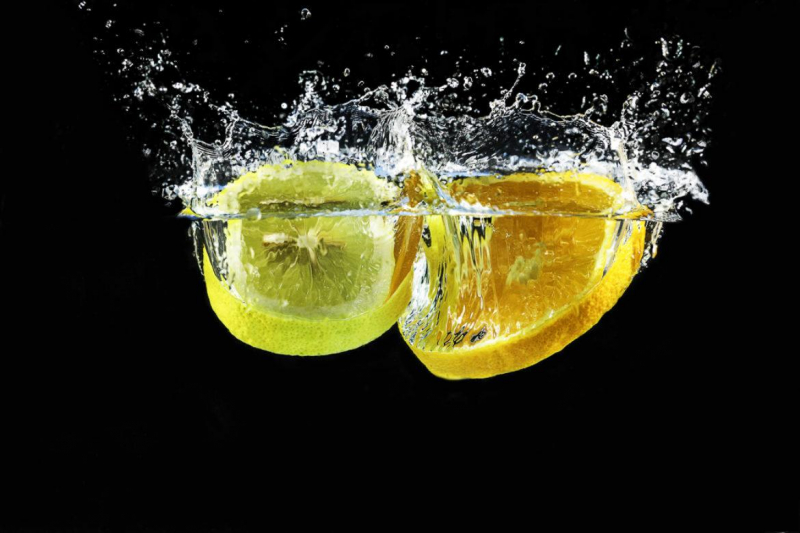
Want to know how to photograph falling objects in water? You are in the right place. In this article, I'm going to give you my tips and tricks for taking one-of-a-kind gorgeous shots of dropped objects in water.
So, if you're ready to take some jaw-dropping photos…
…let's dive in!
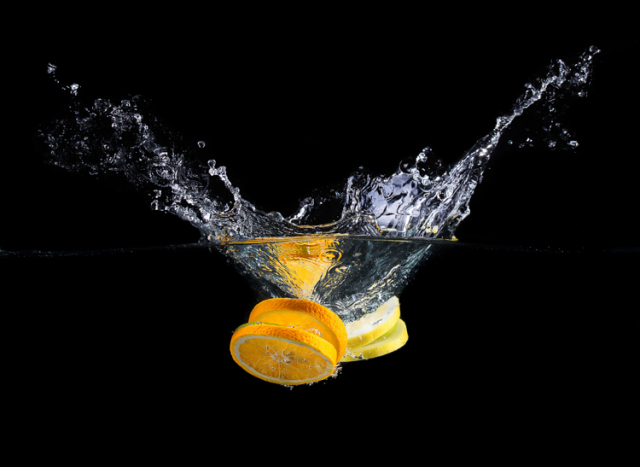
What equipment do you need to photograph falling objects in water?
Luckily the settings for photographing falling objects in water are pretty minimal.
Here's what you should have on hand:
- A transparent glass container, the ideal is an aquarium with a minimum volume of about 60L
- A table covered in black cloth
- A black background (paper or fabric), placed at least a couple of meters away from the aquarium.
If possible, you should also find an assistant: a friend, family member, etc. They will make your life easier.
While you can do it all yourself, it's extremely helpful to have someone who can throw things into the water, get them out, then throw them again and again and again (as you shoot with the camera).
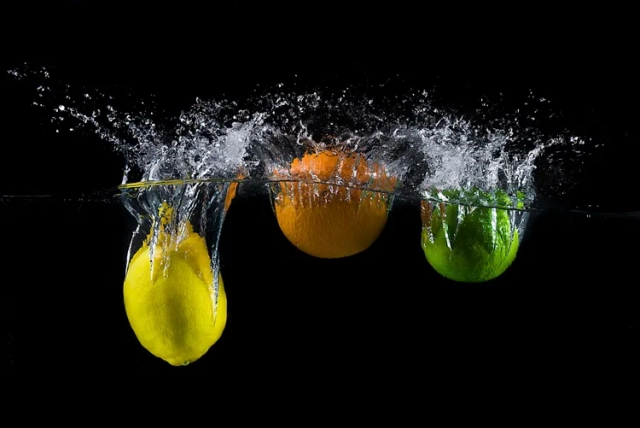
Equipment and subjects
The good news is that you don't need any special equipment to photograph objects falling into the water.
Any decent camera will do, although to get better quality you should use a DSLR or mirrorless camera or micro 4/3 camera with a good lens.
As a general advice I can definitely suggest that you always use a tripod , there are excellent ones already starting at 50 euros; this will make focusing and framing ten times easier.
Finally, you'll need two flashes , one on each side of the tank , aimed directly at your subject (as shown in the photo below). I prefer to use softboxes that allow me to limit the light so that it only hits the subject and doesn't spread all over the scene, which helps to avoid unwanted reflections and lights.
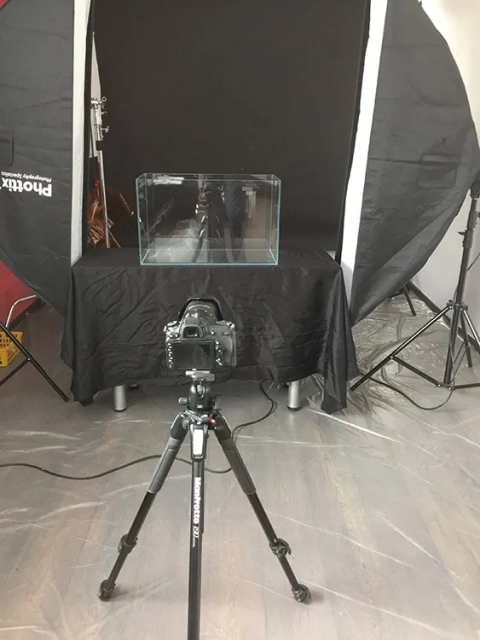
As you can see, a nice plastic sheet, the kind used to protect furniture during painting or other work in progress at home, can also be useful.
As for your subjects to drop in the water:
Use what you like! I personally prefer fruits and vegetables because they vary in size, shape and color. But you could also photograph golf balls, coke cans, old gear, and more!
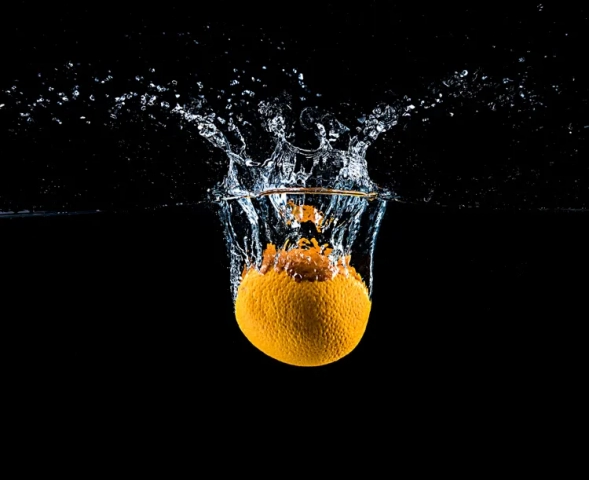
How to set up your studio to photograph falling objects in water
Fill the aquarium with tap water. We recommend filling it halfway or two-thirds full, depending on how far you want the subjects to fall.
If you fill the aquarium with too much water, every splash will cause water to overflow. So, be careful with both flashes and camera when working with water!
Set up your camera in a position where you have the desired shot of the aquarium, leaving enough room above, below and to either side to capture the majority of the splashes.
Once you've positioned the camera, you'll need to set focus manually , as I'll explain in the next section.
Focus the subject manually
For this step, have your assistant hold your subject in the water where you want the splash to occur.
Focus on the subject.
Then set the camera to manual focus or have the camera do the dirty work and then turn off the autofocus. This way, the camera won't have to refocus every time you take a photo, and you'll know that your subject will always be in focus whenever the object falls into its intended position.
How to freeze water splashes
Freezing of subject movement will be performed by the flash, not the camera.
How come?
Because your camera needs to be in sync with your flashes. In most cases, this forces the shutter speed to a maximum of about 1/200th of a second, which is too slow to freeze fast action.
Note: This maximum speed is referred to as the camera's flash sync speed .
Luckily, there is a magic word: flash duration .
It's the length of time the flash emits light (which is much faster than the sync speed of the camera). And if the flash duration is short enough, it will give you the freezing effect you are looking for. Of course you will have to experiment to get the result you want.
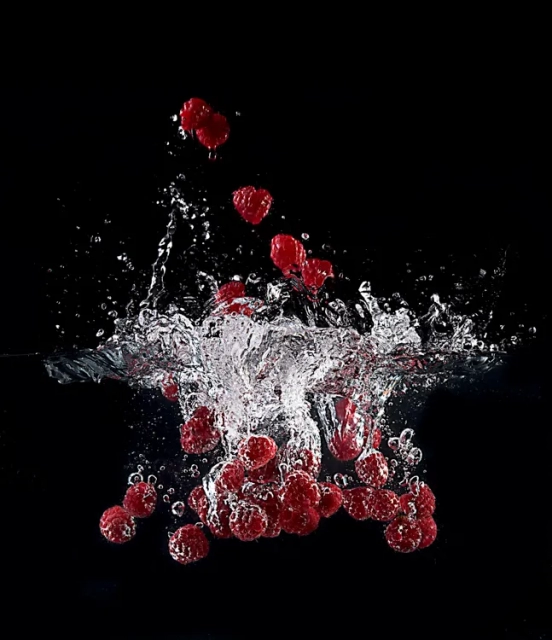
You should be able to use Speedlights for splash photography, as they typically have quite short flash durations, but only at very low power settings of 1/32 or 1/64. Those settings will result in darker shots, but you can compensate by raising the ISO and opening the aperture.
Personally, I prefer to use flashes that allow short times. Most manufacturers disclose the flash duration of their flashes, as well as how much power you get with the shorter flash durations.
For the images in this article, Elinchrom ELC Pro HD 500 flashes were used, which have a shorter flash duration – 1/4000s – at 3.1 power.
For this shot, my camera settings were ISO 100, f/16 and 1/125s (this speed can also be achieved with other less expensive flashes, as they generally all go to at least 1/200th).
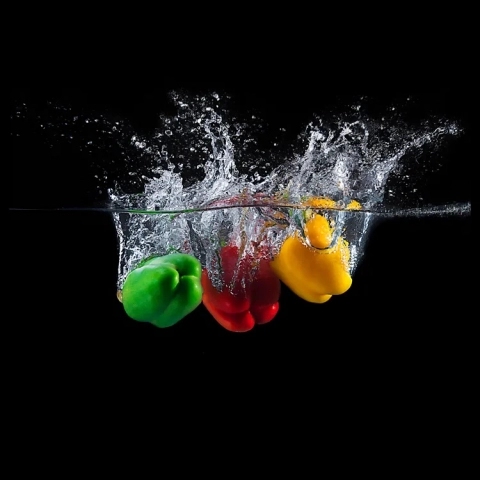
Take pictures of water splashes
This is the fun part! If you have an assistant, you'll need to sync your movements.
Here is the step-by-step process:
Step 1: Count to three.
Step 2: Have your assistant drop the items.
Step 3: Operate the shutter to capture a stunning splash.
I sincerely suggest you repeat these steps for a few hours. I prefer to set my camera to continuous or burst mode (if you have flashes that recharge very quickly) and record three or four images. By doing this, I increase the likelihood of catching the subject and the water spray.
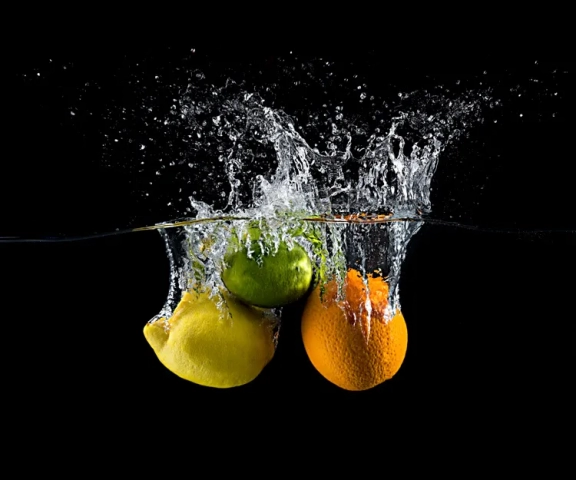
Some quick tips for photography of objects falling into water:
- Use subjects with vivid colors; this way you will have a good separation of the subject from the black background and the white/bluish spot. It will make your photos stand out.
- If you're photographing small subjects, try using a minimum of six or ten pieces at a time.
- Try combining subjects of different sizes, colors and shapes.
- For larger splatters, use subjects with a larger surface area or drop them from a higher position.
- Wash fruit and vegetables before using them. This way, you can keep the water clean for a longer period of time.
- If the water starts to get dirty, change it. This can be rather unpleasant because the tank will be heavy. But the good news is that by changing the water regularly, you'll have to work less in the post-processing phase and will get sharper, cleaner images.
- Frequently clean the front glass of the tank to eliminate the drops of water which tend to accumulate on it.
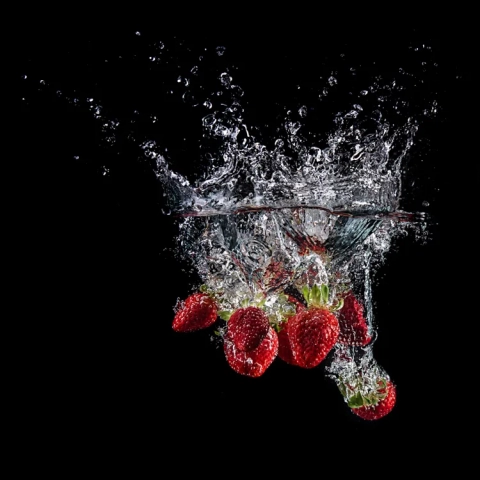
Post-production tips
This part is key! No matter how hard you try to capture the perfect splash, your RAW images will still need some polishing and processing.
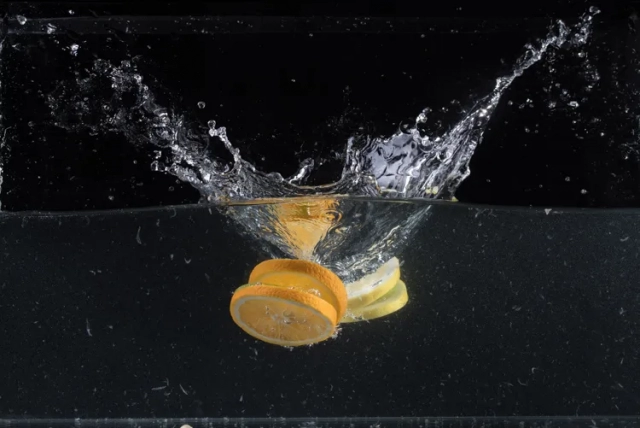 The raw shot of these orange slices.
The raw shot of these orange slices.I only use Lightroom and Photoshop for post-processing, but you can get the effects you want in just about any editing program.
Clean the water
After opening your photo, you need to clean the water first.
I suggest using the Adjustment Brush with the Blacks slider set to -100.
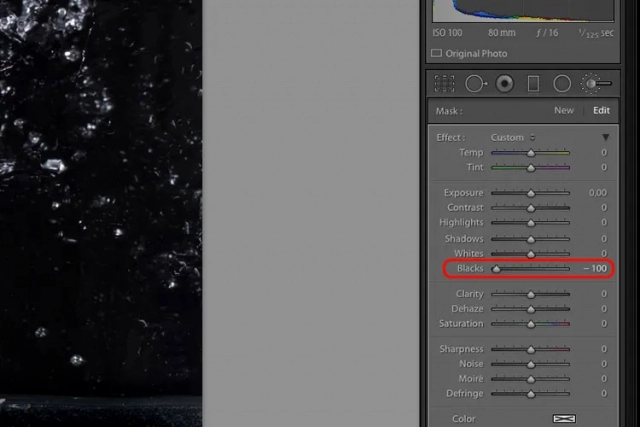 Use the adjustment brush with the blacks set to -100.
Use the adjustment brush with the blacks set to -100.
Apply this brush everywhere except the subjects (it would make them too dark).
You can even use the brush on the splash itself as this will make it cleaner and sharper. But be careful not to overdo it, or you'll miss out on some detail.
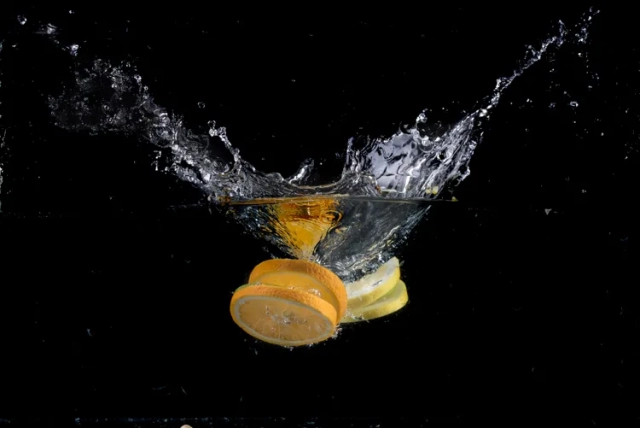 The photo of the oranges after applying the adjustment brush.
The photo of the oranges after applying the adjustment brush.
Final touches
Now open the image in Photoshop, create a new empty layer, select the Brush Tool, then start painting the new layer black.
This will give you a clean black background, but be careful when painting close to subjects (you don't have to paint over them!). You can even get rid of small drops of water that you deem unnecessary. Try to preserve some of the water's surface though.
Once you're done painting, you should sharpen the image . You can also add contrast or saturation depending on the look you're going for.
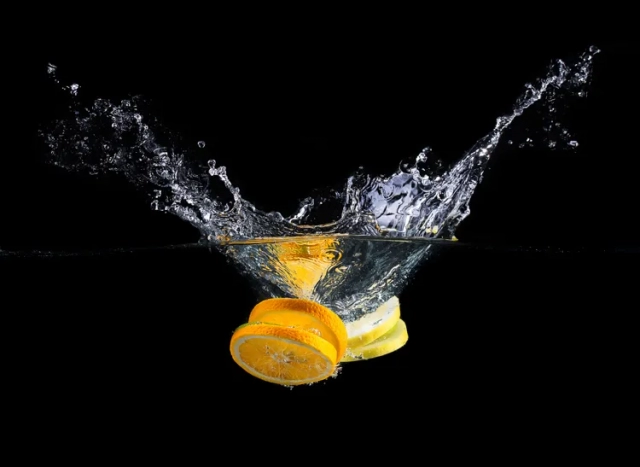
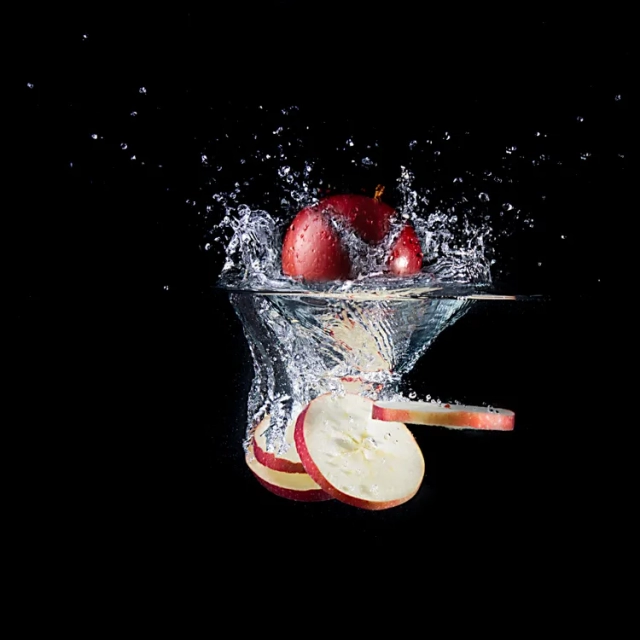
Well now are you ready to try your hand at photographing objects falling into the water?
You now know the setup, techniques and post-processing.
So take some shots! Have fun!
You will love the results.
When you subscribe to the blog, we will send you an e-mail when there are new updates on the site so you wouldn't miss them.
By accepting you will be accessing a service provided by a third-party external to https://www.insightadv.it/


































































Comments